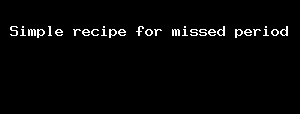profile/6639_20200624_134801.JPG
LeeMinYoung

Simple Recipe For Missed Period
~3.6 mins read
Many people who miss a period will take a test to check for pregnancy. If the pregnancy test is negative, a variety of conditions and factors may be responsible for the lack of menstruation.
Causes
Amenorrhea usually happens when the ovaries stop making enough of the female hormone estrogen. A range of factors, including those below, can cause a lack of estrogen.
1. Weight changes
The rapid gain or loss of a significant amount of weight can lead to hormonal imbalances. These imbalances can cause a person to miss periods initially, but they tend to resolve over time.
2. Stress
Long-term or intense stress can affect the part of the brain that controls the reproductive hormones. This can cause ovulation and periods to stop.
Once the cause of the stress goes or the person learns coping strategies to manage it, their regular cycle may return.
3. Excessive exercise
Excessive exercise can cause missed periods, particularly for people with low body weight or very little body fat. Missing periods due to excessive exercise is called exercise-associated amenorrhea.
4. Producing too much prolactin
Prolactin is a hormone that the body usually makes during breastfeeding. It can halt menstruation and is the reason why most breastfeeding women do not have periods.
In people who are not breastfeeding, a milky discharge from the nipples can signify that the body is making an abnormally high amount of prolactin. Doctors can treat excessive prolactin production with medication.
5. Thyroid problems
The thyroid is a gland that produces hormones to control the body's metabolism.
Hypothyroidism, or an underactive thyroid, is a condition in which the thyroid does not produce enough of these hormones. Hyperthyroidism, or an overactive thyroid, results in the levels of thyroid hormones in the body being too high.
Both conditions can affect the frequency of periods. Other signs to look out for include:
fatigue or extreme tiredness over a prolonged period
hair loss
unexplained weight gain or loss
always feeling cold or being warm all the time
Doctors can usually diagnose thyroid problems using a simple blood test.
6. Polycystic ovary syndrome (PCOS)
People with PCOS have a hormonal imbalance that can affect their overall health and appearance in addition to causing ovarian cysts.
Up to 10 percent of women of childbearing age have PCOS and may have enlarged ovaries with clusters of small, benign cysts.
Signs of PCOS include:
irregular periods or no periods
very light, very heavy, or unpredictable bleeding during periods
skin conditions, such as acne, dark patches, or skin tags
being overweight or obese
thinning hair
sleep apnea
difficulty getting pregnant
excess hair on the face, back, or thighs
7. Eating disorders
Eating disorders, particularly anorexia, can cause periods to stop. This happens when a person's body fat becomes too low for ovulation to occur.
8. Perimenopause
People enter menopause when they have not had a period for at least 12 months. The average age of people entering menopause in the United States is 52 years old. However, the transition to menopause, known as perimenopause, may cause symptoms that begin at a younger age.
The symptoms of perimenopause include:
irregular periods
heavier or lighter periods
hot flashes
problems sleeping
mood swings or irritability
vaginal dryness
less interest in sex.
Now, straight to business:
This remedy is for those that have missed their periods. If your period is not forth coming for long and you are seeking natural ways to bring them back try this recipe, do not go to early menopause.
Get:
Onion(1 big onion)
Lemon(1 big lemon)
1 cup of water
Process:
Crush or grind or blend 1 Big Onion, Boil in 1 cup of water, sieve
and add your squeezed lemon juice and drink this mixture all at
once after dinner.
Do this once a day for 3 days in a week.
profile/6639_20200624_134801.JPG
LeeMinYoung
Hair Loss: Natural Effective Ways To Get Your Hairs Back In Shape Within Seven Days.
~3.0 mins read
It takes time, coupled with prevalent symptoms.
This is why it is believed that it's possible to minimize or prevent the chances of going bald. Because taking note of its early signs, and doing the needful, can make the condition better.
That being said, the symptoms of hair loss include hair fall outs on your pillows when you wake up, an excessive breakage of hair when you comb or brush your hair.
And a definite change in hairline and thinning of the hair.
Be that as it may, it is important to note that these changes could mean different things; as it could be a sign of a serious medical condition.
Here are five natural home remedies for hair loss
1. Onion
Studies have shown that sulfur which is one of the vital components in promoting hair growth and preventing hair loss is richly present in onions.
And eating one to two raw onions every day can help tackle this condition.
This genus also contains several other species variously referred to as onions and cultivated for food, such as the Japanese bunching onion (Allium fistulosum), the tree onion (A. ×proliferum), and the Canada onion (Allium canadense). The name "wild onion" is applied to a number of Allium species, but A. cepa is exclusively known from cultivation. Its ancestral wild original form is not known, although escapes from cultivation have become established in some regions.[4] The onion is most frequently a biennial or a perennial plant, but is usually treated as an annual and harvested in its first growing season.
The onion plant has a fan of hollow, bluish-green leaves and its bulb at the base of the plant begins to swell when a certain day-length is reached. The bulbs are composed of shortened, compressed, underground stems surrounded by fleshy modified scale (leaves) that envelop a central bud at the tip of the stem. In the autumn (or in spring, in the case of overwintering onions), the foliage dies down and the outer layers of the bulb become dry and brittle. The crop is harvested and dried and the onions are ready for use or storage. The crop is prone to attack by a number of pests and diseases, particularly the onion fly, the onion eelworm, and various fungi cause rotting. Some varieties of A. cepa, such as shallotsand potato onions, produce multiple bulbs.
Onions are cultivated and used around the world. As a food item, they are usually served cooked, as a vegetable or part of a prepared savoury dish, but can also be eaten raw or used to make pickles or chutneys. They are pungent when chopped and contain certain chemical substances which irritate the eyes.
2. Coconut milk
This is a trusted ancient remedy to regrow hair on the bald head. And it can be achieved by combining a mixture of 1/4 cup of coconut milk, two tablespoons of yogurt and one tablespoon of honey.
Coconut milk is differentiated into subtypes based on fat content. They can be generalized into coconut cream (or thick coconut milk) with the highest amount of fat; coconut milk (or thin coconut milk) with a maximum of around 20% fat; and coconut skim milk with negligible amounts of fat. This terminology is not always followed in commercial coconut milk sold in western countries.
Coconut milk can also be used to produce milk substitutes (differentiated as "coconut milk beverages"). These products are not the same as regular coconut milk products which are meant for cooking, not drinking. A sweetened, processed, coconut milk product from Puerto Rico is also known as cream of coconut. It is used in many desserts and beverages like the piña colada, though it should not be confused with coconut cream.
. Egg
Studies have shown that egg has several ingredients that can help prevent or control hair loss. It is a rich source of sulphur and ahs phosphorous, selenium, iodine, zinc and protein.
The combination of these help promote hair growth.
Advertisement

Link socials
Matches
Loading...